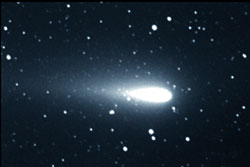 If you stay outside a few hours past sunset in May you will witness a sky that is moving into its summer phase. Rising from the eastern horizon about an hour after sunset is the brilliant star Vega, the first star of the Summer Triangle. Vega is 50 times brighter than the Sun and only 26 light years away so it beams strongly in our night sky. (See sky chart).
If you stay outside a few hours past sunset in May you will witness a sky that is moving into its summer phase. Rising from the eastern horizon about an hour after sunset is the brilliant star Vega, the first star of the Summer Triangle. Vega is 50 times brighter than the Sun and only 26 light years away so it beams strongly in our night sky. (See sky chart).
Possibly the most fascinating of all celestial attractions is the passing Comet 73P (Schwassmann-Wachmann-3). Throughout May it will become prominent in our northeast sky after midnight. In 1995, Comet 73P split into at least three 'mini-comets' flying single file through space. Train your binoculars towards the constellations Cygnus and Pegasus on 12-14 May to locate it.
Don't miss the great celestial gathering of the crescent Moon, Saturn, Mars and the Beehive star cluster (M44) just above the western horizon on 31 May. Consider and compare the astounding distances of these celestial attractions-240,000 miles to the moon; 50,000,000 miles to Mars; 800,000,000 miles to Saturn and 3,400,000,000,000,000 miles to M44!
Other May highlights:
Sun
The Sun is in the constellation of Aries at the start of May, moving into Taurus on the 14th.
Moon
The Moon meets Saturn on the 3rd and Jupiter on the 11th, before coming close to Venus on the 24th. It passes just to the right of Mercury in a conjunction on the 27th and meets Saturn again on the 31st.
Mercury
Mercury is behind the Sun on 14 May. By the end of the month it will be just above the western horizon after sunset but in the twilight it won't be easy to see this elusive little planet.
Venus
Venus is a brilliant morning star, visible low in the east at dawn, an hour before sunrise. After five months of flight, the European Space Agency's Venus Express spacecraft has arrived at our cloud blanketed 'evil twin' to scan its atmosphere and surface.
Mars
Mars is moving rapidly eastward across the constellation of Gemini, below the twin stars, and towards Saturn. Mars is 20 degrees above the western horizon at sunset and sets close to 11:30 PM.
Jupiter
The King of Planets, Jupiter reaches opposition on 4 May. However, it is at its brightest of the year and nearest to Earth one day later. Retrograding in Libra, it is out all night.
Saturn
Saturn is moving slowly south-eastward in Cancer. It's in the western sky after sunset, to the left of the Gemini Twin stars Castor and Pollux. Saturn looks like a bright star, brighter than the twins.
Meteors
The Eta Aquarids peak on 5 May as the Earth passes through the centre of a debris trail left by Comet Halley in 1986. These showers appear to come from the constellation of Aquarius. At their peak, we may observe up to 30 'shooting-stars' every hour.


